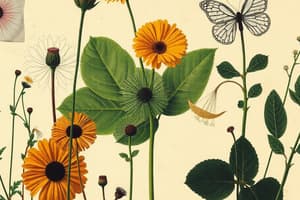Podcast
Questions and Answers
What is a characteristic that plants share with other living things?
What is a characteristic that plants share with other living things?
- Presence of chlorophyll
- Rigid cell wall
- Asexual reproduction
- Ability to grow (correct)
What is the function of chlorophyll in plant cells?
What is the function of chlorophyll in plant cells?
- To absorb water from the soil
- To produce their own food (correct)
- To respond to changes in the environment
- To transport nutrients within the plant
What is the main difference between lower plants and higher plants?
What is the main difference between lower plants and higher plants?
- Lower plants have flowers, while higher plants do not
- Lower plants have roots, while higher plants do not
- Lower plants reproduce asexually, while higher plants reproduce sexually (correct)
- Lower plants have stems, while higher plants do not
What is unique to plant cells compared to other eukaryotic cells?
What is unique to plant cells compared to other eukaryotic cells?
What is a characteristic that is common to all plants, but not exclusive to plants?
What is a characteristic that is common to all plants, but not exclusive to plants?
What is the main characteristic of non-vascular plants?
What is the main characteristic of non-vascular plants?
What is the reproductive organ of gymnosperms?
What is the reproductive organ of gymnosperms?
What is the main difference between gymnosperms and angiosperms?
What is the main difference between gymnosperms and angiosperms?
What is the function of the root system in a plant?
What is the function of the root system in a plant?
Which of the following is NOT a part of the shoot system?
Which of the following is NOT a part of the shoot system?
Flashcards are hidden until you start studying
Study Notes
Characteristics of Plants
- Plants are living things that grow, reproduce, and respond to changes in the environment.
- They are multicellular, made up of many eukaryotic cells with well-defined nuclei and membrane-bound organelles.
- Plant cells have a rigid cell wall made primarily of cellulose, in addition to the cell membrane.
- Plants are autotrophic (self-feeding), using the green pigment chlorophyll to absorb sunlight and produce their own food.
- They are sessile, remaining fixed at one place, firmly anchored to the soil by their root.
- Plants practice both asexual and sexual reproduction patterns.
Types of Plants
- Flowering plants (Angiosperms) have well-developed root, stem, and leaves, and produce seeds within a fruit.
- Non-flowering plants (Gymnosperms) have well-developed root, stem, and leaves, but reproduce using cones and produce naked seeds.
- Non-vascular plants (Mosses and Liverworts) are small, seedless, and do not have flowers, fruits, or transporting vessels.
Structure and Function of Plant Parts
- The shoot system includes organs such as stem, branches, leaves, buds, flowers, and fruits.
- The root system includes the primary or tap root, lateral or branch roots, root hairs, and root cap.
- Roots are distinguished from underground stems in that they don't bear leaves or buds.
- Leaves have a petiole (leaf stalk), lamina (leaf blade), and veins that transport water, nutrients, and food.
- Roots have a root cap, root hairs, and absorbing regions that absorb water and nutrients from the soil.
Studying That Suits You
Use AI to generate personalized quizzes and flashcards to suit your learning preferences.




